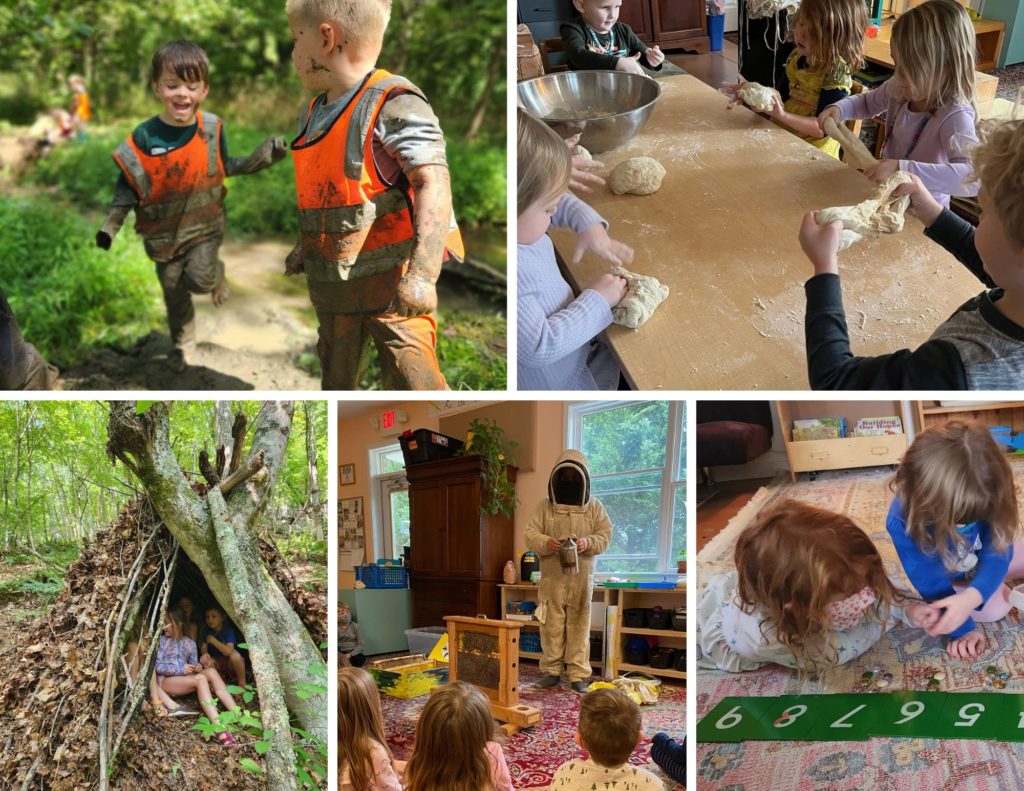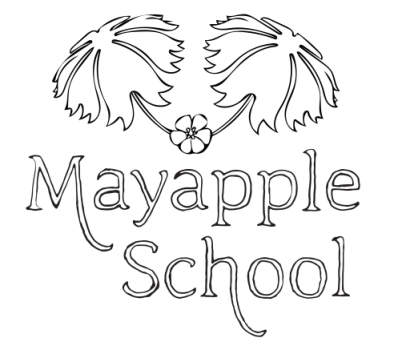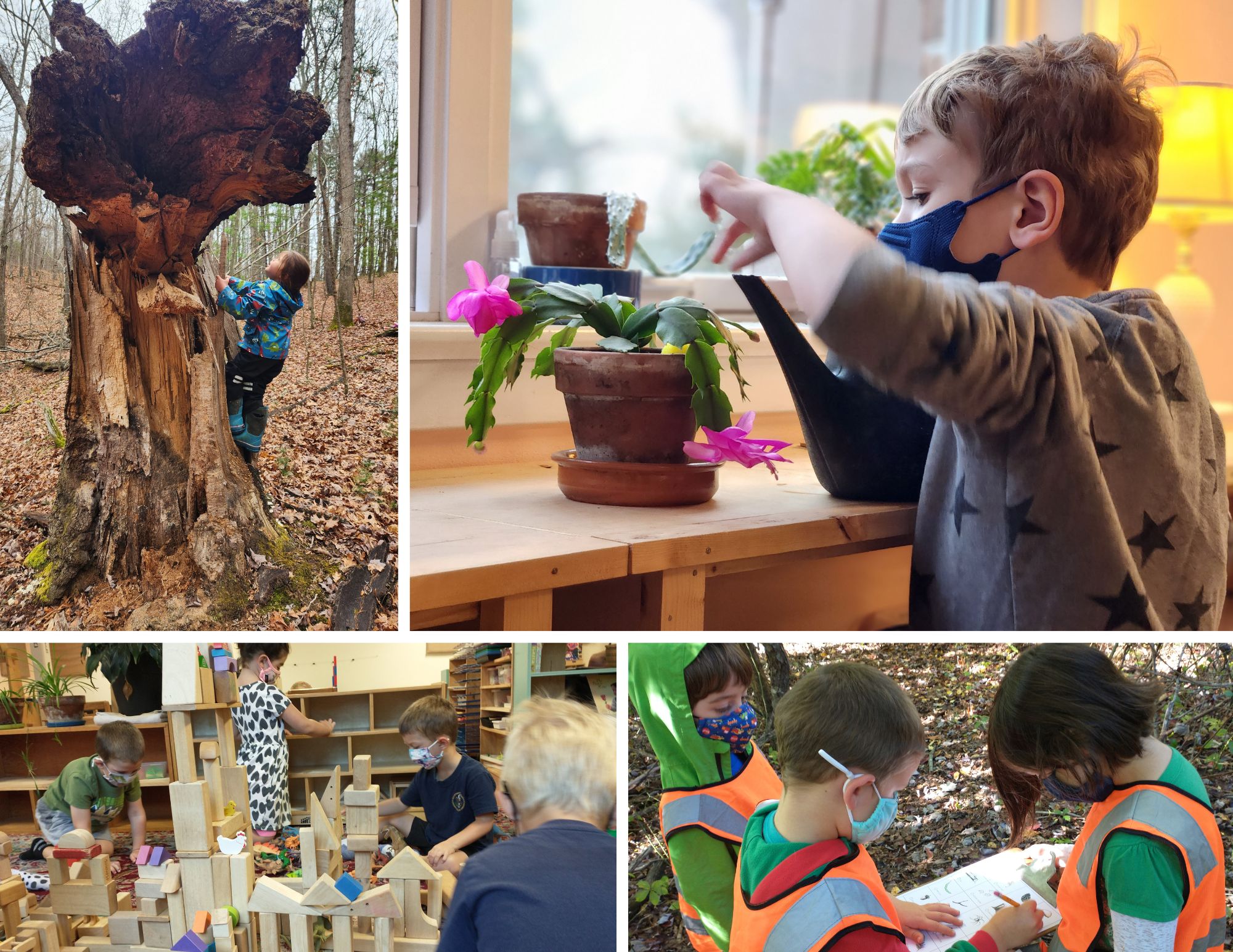Our Kinderforest Application is Now Available! There are currently spots available in the class. This information was last updated on 4/8/2024.
Q. What is Kinderforest at The Mayapple School?
A.. Kinderforest is a Pre-K+ program for five year old children at The Mayapple School in Blacksburg, Virginia, with a focus on nature education and exploration. Program enrollment is for 5 days per week for 195 days in a school year, from 8:45 am to 3:15 pm, with a maximum of eight children in the group with one teacher.
Q. What will my child learn in the Kinderforest Program?
A. The following standards are used to plan instruction:
- Lessons that support ALL of the objects for the Kindergarten Standards of Learning in English are a part of the Kinderforest program.
- Lessons that support ALL of the objectives for the Kindergarten Standards of Learning in Math are a part of the Kinderforest program.
- Lessons that support ALL of the sub areas of the five core competencies are a part of the Kinderforest program. This includes direct instruction and discussion on diversity and tolerance.
- Virginia is not one of the 18 states that have standardized objectives that align with CASEL for Social and Emotional Learning. Objectives from other states may be referenced.
- Environmental Education
- Children’s Environmental Kinship Guide – Lessons that support ALL of the sub areas for the four “experiences of being” in relationship to the natural world are a part of the Kinderforest program.
- K – 4 Environmental Education Guidelines for Excellence – Lessons that support all four strands are a part of the Kinderforest program. However, because these guidelines encompass more than one grade, not all sub areas of each strand will be included in the Kinderforest program.
- Special Projects
- Virginia Standards of Learning are available for many subject areas. When children’s special projects coincide with these standards, planned lessons may align with few, some, or many objectives.
- During Special Projects, children have the opportunity to create their own learning objectives. These may or may not align with the standards listed above.
Q. How will families be involved in their child’s Kinderforest education?
A. Parents are expected to be a part of their child’s education! Opportunities include:
- Parent Teacher Conferences – Parents will meet with the teacher twice per year to discuss their child’s progress within English, Math, Social Emotional Learning, Environmental Education, and Special Projects, which encompasses the class’ and your child’s recent inquiries and could could include anything from fine arts to scientific inquiry, engineering to food studies.
- Parent Volunteering – A commitment of 12 hours of adult volunteer time per school year is required for each enrolled Kinderforest student. These 12 hours are requested of families throughout the school year between the hours of 10:30 am and 12:30 pm or 10 am and 2 pm to support our Price Park explorations. Families unable to volunteer between those hours have an option of paying their way out of the volunteer commitment at $19 per hour. Other volunteering, such as working on our outdoor classroom, are encouraged and appreciated, but not required.
- School events – Other school events in the past have included art shows, literacy breakfasts, restaurant nights, and fundraisers.
Q. What is the daily schedule? What could a day at Kinderforest be like for my child?
A. Like our preschool routine, freedom within routines is offered. Two additional structured periods, one in the morning and one in the afternoon, offer opportunities for deliberate skills building in Math and Literacy topics. Project based learning and outdoor exploration periods continue as important components of the day.
The Daily Routine is expanded below. In italics is a short story for each part of the day that describes a possible day at Kinderforest, based on a previous year’s Kinderforest activities and possibilities for our new location near Price Park! Some main objectives reached for that lesson on that sample day are also listed.
Daily Routines and Curriculum:
8:45 – 9:15 am Flexible Drop Off
8:45 – 9:30 Free Choices
Children may work by themselves or with others with the materials in the classroom. This will often look like and should feel like “play” to the children. Today, two children are writing “secret messages” to each other that reveal where the “hidden treasure” will be. This is a variation of yesterday’s work, where children buried small items in the sandbox and gave each other clues about what was underneath the sand, without naming the object. Three other children work with a building toy, adding their own spin on the visual plans to create a “castle.” Another child, just entering the classroom, completes the “Mayapple Message.” Today, it asks, “If you could be a bird for a day, what bird would you choose?” A field guide to birds is propped nearby to offer inspiration. Two more children roll out yoga mats, then choose a partner pose to try out from the yoga cards. The teacher rotates among the children, offering encouragement, reminders, and support as needed.
9:30 – 10:00 Nature Stories and Social Emotional Learning
After cleaning up their choices, our class gathers in a large group. We greet each other every day and enjoy songs, books, games, and activities that help us learn about ourselves, each other, and the natural world. Today is a winter day, but we’re still waiting for snow– so today, we have fun with the “snowball greeting,” where children find the child whose name is on the “snowball” they catch, saying “good morning” and returning their snowball. After our greeting, we refocus by singing “The North Wind Doth Blow.” Next, the teacher uses a “Once upon a time” oral story to introduce the concept of “mixed flocks” of birds that work together in winter to search for food and look out for predators. After the story, children look at pictures of winter birds that they have learned about so far at school, and discuss what they remember about each bird. Using clues from the stories, they make predictions about what birds they might find together in the winter, and make plans to look for these groups outside. Just like winter flocking birds, in strong groups of humans, not everybody is the same. To highlight this concept, we play a game of “The Winds Blow…” where children move to different areas of the room to show their belonging in different categories. (Guidelines for Excellence, K-4 Environmental Education: 2.1.B Learners identify basic similarities and differences among a wide variety of living organisms. They explain ways that living organisms, including humans, affect the environment in which they live, and how their environment affects them. CASEL 5: Identifying Personal Assets)
10:00 – 10:35 Math
In this block of time, we learn various math concepts such as pattern making, subitizing, concept of 0, basic math functions, spatial awareness, and fractions using hands-on materials such as base 10 blocks, geometric shapes, balance scale, coins, and fraction circles. Depending on the lesson, children may work in small groups, independently, one-on-one with a teacher, or in a large group. Today, we review our learning about initial sorting work we had started on earlier that week, and name properties we can sort by. Then, some students work individually with sets of seashells to sort them into increasingly specific groups. Four of the students work together to figure out how to sort a group of classroom objects. At the end of our work, we discuss how we decided to sort our objects, and add to our properties list as a whole group before cleaning up. Later that week, we’ll use some of the same materials to learn about pattern making. (Virginia SOL: K.MG.1 The student will reason mathematically by making direct comparisons between two objects or events using the attributes of length, height, weight, volume, and time.)
10:35 – 11:00 Outdoor Transition, bathroom break, and snack .
11:00 – 12:30 Outdoor Explorations
Students explore the outdoor classroom on school grounds or journey to nearby Price Park. Teachers offer support to students in special activities that change with the season, student interest, and the discoveries that only nature can provide. We journey to Price Park with the preschool classroom, or with an adult volunteer with just the Kinderforest. Today, a preschool parent joins us on our adventure. It’s already above freezing outside– not too cold, so we can have snack outside. We take our snacks and water bottles with us to Price Park, and have snack at a picnic table at “The Meadow.” It’s a sunny day, so we hear some birds calling as we eat. We hear a chickadee, but we can’t see it. When we hear another type of bird, the parent volunteer wonders aloud what kind of bird it might be– and the students begin explaining that it could be a “friend bird” for the chickadee. After snack, we walk a little way into the woods, where students had started making “forts” a few weeks ago. The parent volunteer helps some students collect branches for their building project. Two other children look through the brown and crunchy leaves underfoot for the largest leaves, then look for matching “baby” leaves. When the teacher joins them, she names the leaves and asks for help finding matches, too. One of the fort builders wants to add leaves to her fort, and the leaf collectors negotiate with her for special “baby leaf” protection. (Children’s Environmental Kinship Guide: Playing creatively and imaginatively with open ended natural materials.)
12:30 – 1:00 Lunch
1:00 – 1:10 Jobs and bathroom break
1:10 – 1:45 R & R (Rest & Reading)
In this block of time, we learn various language and literacy skills. Phonics, phonemic awareness, conversational skills, vocabulary expansion, comprehension strategies, story telling, writing, and print awareness are all covered throughout the year. These lessons are held in a cozy atmosphere with warm blankets and snuggles with stuffed animals encouraged! Today’s lesson begins with a review on segmenting sounds and matching phonemes and graphemes, skills needed for writing. Today, students are working to finish up their picture and a sentence about what they did at the Science Fair they created for the preschool students and families last week, using both sight words and words that they need to “sound out.” (“I made ____.”) The teacher offers support as needed. (Virginia English SOL K.12.c Use letters and beginning consonant sounds to spell phonetically words to describe pictures or write about experiences)
1:45 – 2:15 Special Projects
During this time, students get to pursue their own questions and passions about topics of their choice. Teachers don’t necessarily know ahead of time what special projects students will want to explore – write and perform our own play? learn about restaurants and host our own restaurant night? learn about famous artists and create our own art show? Whatever the case may be, students and teachers work together to figure out how to best explore topics of interest. Lately, the Kinderforest students have been asking for “The Play Together Game,” where students role play different characters from a book over a number of repeated readings over time, so the teacher suggested that they work together to choose the next book today. The children look through and talk about the pictures they see in the books, and the teacher reads parts of the book and offers descriptions of unfamiliar stories. Two books are chosen to vote between, and the vote is planned for the following day. The students have recently finished up on an extensive project – offering a “science fair” for their parents and the preschool students and families, so this shorter choice today is the perfect change of pace.
2:15 – 3:15 Pack up and Outdoor Explorations
Children work and play in the outdoor classroom on self-chosen activities. Today, two of the students are excited to bring their “secret messages” outside to the sandbox that they had written that morning. Another child joins them as the “finder” of the “treasure.” Two children climb on the climbing log, then move to the slides. The other three children join in a pretend game with members of the preschool classroom, playing “Unicorn Family.” The teacher keeps an eye on the climbing children while she jots down notes on individual children’s learning for that day.
Q. Will my child have the opportunity for extended outdoor explorations? What will that look like?
A. For extended explorations at Price Park, our daily schedule will shift and will look something like this:
8:45 – 9:15 Flexible Drop Off and Open Learning
9:15 – 9:45 Nature Stories, Planning & Preparing
9:45 – 10:00 Bathroom Break and Outdoor Transition
10:00 – 2:00 Forest Trip
2:00 – 2:30 Bathroom Break, Clean Up & Jobs
2:30 – 3:05 R & R
3:05 – 3:15 Pack up & Dismissal
Extended forest trips will allow us to explore further afield and offer opportunities to extend learning in special projects or other subject areas. Perhaps we’ll use our map reading skills to look for the Gingerbread man after a read aloud and write responses about where we found him (English, Geography). Maybe we’ll measure and count the crayfish we find in the creek that day during a certain time period, comparing that day’s temperature and crayfish count to other days’ (Math, Environmental Education, Science). Another day, students might choose to collect Autumn Olives for making jam and role play feeding babies and animals with the berries (Food Studies, Dramatic Arts).
Q. Can my child attend Kinderforest in lieu of Kindergarten?
A. Virginia code has compulsory education laws that do allow for five year olds to attend private pre-kindergarten programs. “Further, in the case of any five-year-old child who is subject to the provisions of this subsection, the requirements of this section may be alternatively satisfied by causing the child to attend any public educational pre-kindergarten program, including a Head Start program, or in a private, denominational, or parochial educational pre-kindergarten program.” https://law.lis.virginia.gov/vacode/22.1-254/
- Kinderforest is part of a preschool program licensed through the Virginia Department of Education. Like the rest of The Mayapple School, we accept Child Care Subsidy payments (for children who are not yet 5 by September 1) and are subject to licensing inspections and requirements. Children who are already 5 by September 1 are not eligible to receive Child Care Subsidy funds in Virginia.
- The Kinderforest program may be a good fit for families who feel their children are not yet ready for the public school environment, and could be a good choice for both children who will enter a Kindergarten or a First Grade classroom the following school year. It is recommended to schedule a talk with the Kinderforest teacher to make an informed decision. (Melissa West will be the Kinderforest teacher for the 2024/2025 school year.)
Q. How do I sign my child up for the Kinderforest program?
A. The Kinderforest tuition schedule and application 2024 is now available. Applications can be mailed to 404 Mt. Tabor Rd. Blacksburg VA 24060 or made in person. Admissions will be made on a rolling basis until the class is filled. If your child does not currently attend The Mayapple School preschool program, please schedule a visit here. You can also email your questions to mayapplemelissa@gmail.com or request a time to talk by phone.


